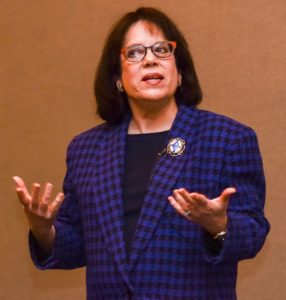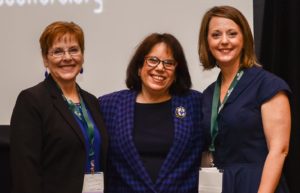 Deborah Blum
Deborah Blum
Director, Knight Science Journalism Program
Massachusetts Institute of Technology
Cambridge, Massachusetts
When entering “Chemistry is” as a search term in Google, the decidedly negative words boring, hard, and useless appear as top-tier suggestions to complete the phrase. This indicator of the general public’s prevailing attitude toward chemistry epitomizes the challenge scientists face in communicating the importance and relevance of their trade to the average citizen. However, this year’s keynote speaker has been steadily crafting a fascinating means to that end.
 Deborah Blum, a Pulitzer Prize winner and a one-time chemistry major, made her 2010 book The Poisoner’s Handbook: Murder and the Birth of Forensic Medicine in Jazz Age New York the centerpiece of a riveting talk about how the combination of nonfiction material and narrative storytelling—a genre known as creative nonfiction—can be a powerful tool for science writers to engage the public in matters of science and help them apply scientific principles to their daily lives. Blum stressed that in addition to a firm narrative structure, every story must have a strong central idea to serve as a pivot point for that structure. Somewhat ironically, her initial attempt to use the pivotal word Chemistry in the subtitle of The Poisoner’s Handbook was rejected by her publisher for fear that its inclusion would result in poor sales. She compromised, but only after a debate that exemplified the plight of science writers who are attempting to create what Blum called a “common sense filter” for society.
Deborah Blum, a Pulitzer Prize winner and a one-time chemistry major, made her 2010 book The Poisoner’s Handbook: Murder and the Birth of Forensic Medicine in Jazz Age New York the centerpiece of a riveting talk about how the combination of nonfiction material and narrative storytelling—a genre known as creative nonfiction—can be a powerful tool for science writers to engage the public in matters of science and help them apply scientific principles to their daily lives. Blum stressed that in addition to a firm narrative structure, every story must have a strong central idea to serve as a pivot point for that structure. Somewhat ironically, her initial attempt to use the pivotal word Chemistry in the subtitle of The Poisoner’s Handbook was rejected by her publisher for fear that its inclusion would result in poor sales. She compromised, but only after a debate that exemplified the plight of science writers who are attempting to create what Blum called a “common sense filter” for society.
Quoting Emily Dickinson’s poem “Tell all the truth but tell it slant,” Blum opined a story that is inherently good should capture a reader’s attention—the trick is developing a compelling narrative arc to enhance it. Blum further noted that her goal is to achieve the delicate balance of weaving a suitable amount of science into the fabric of her narrative, but not so much that her readers suffer from information overload. Stating that she does not write for scientists but rather for people who have become disaffected toward science, Blum said her aim in writing creative nonfiction is to “pull people toward the campfire” with suspense, dialogue, strong characters, and a narrative arc—components that are critical to a good story.
The Poisoner’s Handbook has all of these components, and in droves. For attendees who had not read the book, Blum recounted a handful of the many actual—and gruesome—criminal investigations in New York City in the early twentieth century that were integral to the birth of forensic medicine and its eventual recognition as a credible and vital field. Using chemistry to unravel the mysteries of poisoning tales both accidental and nefarious, Blum enthralled her modern-day audience in the same way her protagonists, forensic medicine pioneers Charles Norris and Alexander Gettler, ultimately captivated a skeptical public by revealing the science behind the stories.
The good news, according to Blum, is that science writing is experiencing a boom. The Knight Science Journalism Program, where she currently serves as Director, is one among many organizations that have been focusing on the intersection of science and society in recent years. In response to a follow-up question from CSE president Angela Cochran about overblown reports of scientific studies by the media, Blum said this focus is imperative in an era in which mainstream journalists often report individual studies as singular, significant events rather than as part of a larger, comprehensive process. She added that this culture clash between journalism and science is what inspires the National Association of Science Writers (of which Blum is a member) in their crusade against “single-study reporting” and drives their ongoing dialogue about reporting science responsibly to a disengaged and even distrustful public.
All is not lost, however. Google also suggests completing the phrase “Chemistry is” with the words life and fun. With journalists like Deborah Blum leading a new wave of science writers, perhaps these terms will one day represent the average citizen’s predominant association with science.
